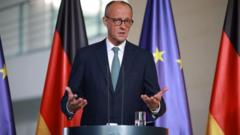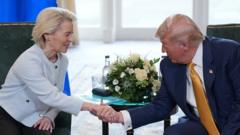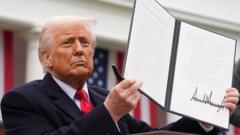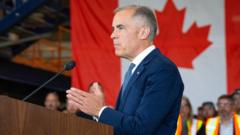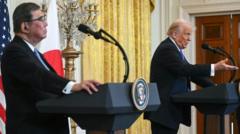**The recent trade deal between the US and EU showcases mutual claims of success but underscores uncertainties in the details and future negotiations.**
**New US-EU Trade Agreement: Analyzing the Prospects and Pitfalls of Tariff Negotiations**

**New US-EU Trade Agreement: Analyzing the Prospects and Pitfalls of Tariff Negotiations**
**A comprehensive look at the recent trade agreement between the US and EU, emphasizing its implications and challenges ahead.**
After a series of intense negotiations, the United States and the European Union have reached a significant trade agreement, marking a crucial moment just as the US is poised for further tariff discussions with China. The agreement, solidified by direct talks between US and EU leaders, underscores the importance of personal diplomacy in trade negotiations, as previously seen with other deals negotiated by President Donald Trump.
This latest arrangement is particularly vital as the US and EU navigate what is accredited as "the world's largest bilateral trade and investment relationship." Both parties have reasons to herald the deal as a win. The EU succeeded in mitigating a potential 30% tariff down to a less severe 15%, while the US anticipates a substantial $90 billion in tariff revenue based on last year’s trading outcomes in addition to a projected $600 billion in investment flowing into the country. However, while both sides tout success, many specifics remain opaque, especially concerning the timelines and sectors that will see this investment.
The deal stands as a testament to the protracted struggle between Washington and the EU. Both sides engaged in rigorous negotiation tactics, pushing talks to the final hours before settling an agreement that neither side wished to extend past the August 1 deadline. President Trump has long criticized European trade practices, particularly citing a significant trade deficit last year where the US imported $236 billion more from the EU than it exported. He contends this trend represents unnecessary outflows of American wealth, neglecting the multifaceted nature of global trade.
Moreover, Trump has persistently denounced the strict regulatory barriers within the EU, which restrict US entities from penetrating European markets as easily as European firms access US markets. The implications of this trade deal could reveal efforts to ameliorate these trade imbalances, though President von der Leyen indicated during the announcement that a reevaluation of these deficits is essential for their “excellent trade relation” to continue thriving sustainably.
The nuances of the US-EU deal reflect Trump's determination to reshape international trade relations, particularly given the EU's complexity as a conglomerate of 27 diverse nations. This agreement follows prior negotiations with other global players, including Japan, the UK, Vietnam, and Indonesia, indicating a strategic maneuver by the US to establish favorable terms across major economies.
Looking forward, the timing of this agreement coincides with impending negotiations between the US and China in Stockholm, where high tariff discussions are also on the agenda. Expectations are that tariffs may be paused for up to three months; however, ongoing friction with China suggests potential obstacles that could derail progress amid an existing climate of trade tensions. As both sides delve deeper into these ongoing discussions, concern lingers that unresolved issues could lead global trade into unpredictable waters in the near future.

